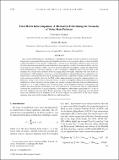| dc.contributor.author | Gebbie, Geoffrey | |
| dc.contributor.author | Huybers, Peter | |
| dc.date.accessioned | 2011-04-06T17:12:58Z | |
| dc.date.available | 2011-04-06T17:12:58Z | |
| dc.date.issued | 2010-08 | |
| dc.date.submitted | 2010-03 | |
| dc.identifier.issn | 0022-3670 | |
| dc.identifier.issn | 1520-0485 | |
| dc.identifier.uri | http://hdl.handle.net/1721.1/62150 | |
| dc.description.abstract | Ocean tracer distributions have long been used to decompose the deep ocean into constituent water masses, but previous inverse methods have generally been limited to just a few water masses that have been defined by a subjective choice of static property combinations. Through air–sea interaction and upper-ocean processes, all surface locations are potential sources of distinct tracer properties, and thus it is natural to define a distinct water type for each surface site. Here, a new box inversion method is developed to explore the contributions of all surface locations to the ocean interior, as well as the degree to which the observed tracer fields can be explained by a steady-state circulation with unchanging surface-boundary conditions. The total matrix intercomparison (TMI) method is a novel way to invert observations to solve for the pathways connecting every surface point to every interior point. In the limiting case that the circulation is steady and that five conservative tracers are perfectly observed, the TMI method unambiguously recovers the complete pathways information, owing to the fact that each grid box has, at most, six neighbors. Modern-day climatologies of temperature, salinity, phosphate, nitrate, oxygen, and oxygen-18/oxygen-16 isotope ratios are simultaneously inverted at 4° × 4° grid resolution with 33 vertical levels. Using boundary conditions at the surface and seafloor, the entire interior distribution of the observed tracers is reconstructed using the TMI method. Assuming that seafloor fluxes of tracer properties can be neglected, the method suggests that 25% or less of the water residing in the deep North Pacific originated in the North Atlantic. Integrating over the global ocean, the Southern Ocean is dominant, as the inversion indicates that almost 60% of the ocean volume originates from south of the Southern Hemisphere subtropical front. | en_US |
| dc.language.iso | en_US | |
| dc.publisher | American Meteorological Society | en_US |
| dc.relation.isversionof | http://dx.doi.org/10.1175/2010jpo4272.1 | en_US |
| dc.rights | Article is made available in accordance with the publisher's policy and may be subject to US copyright law. Please refer to the publisher's site for terms of use. | en_US |
| dc.source | American Meteorological Society | en_US |
| dc.title | Total Matrix Intercomparison: A Method for Determining the Geometry of Water-Mass Pathways | en_US |
| dc.type | Article | en_US |
| dc.identifier.citation | Gebbie, Geoffrey, and Peter Huybers. “Total Matrix Intercomparison: A Method for Determining the Geometry of Water-Mass Pathways.” Journal of Physical Oceanography 40.8 (2010) : 1710-1728. c2010 American Meteorological Society | en_US |
| dc.contributor.department | Joint Program in Oceanography/Applied Ocean Science and Engineering | en_US |
| dc.contributor.department | Woods Hole Oceanographic Institution | en_US |
| dc.contributor.approver | Gebbie, Geoffrey | |
| dc.contributor.mitauthor | Gebbie, Geoffrey | |
| dc.relation.journal | Journal of Physical Oceanography | en_US |
| dc.eprint.version | Final published version | en_US |
| dc.type.uri | http://purl.org/eprint/type/JournalArticle | en_US |
| eprint.status | http://purl.org/eprint/status/PeerReviewed | en_US |
| dspace.orderedauthors | Gebbie, Geoffrey; Huybers, Peter | en |
| mit.license | PUBLISHER_POLICY | en_US |
| mit.metadata.status | Complete | |
